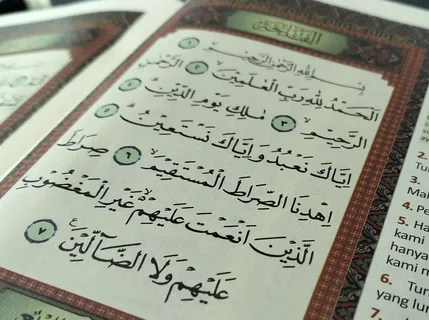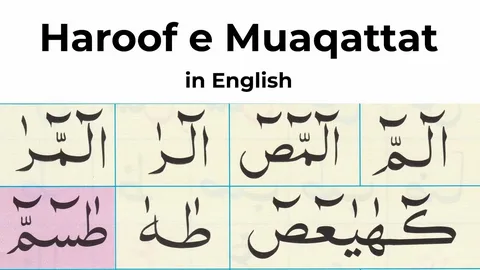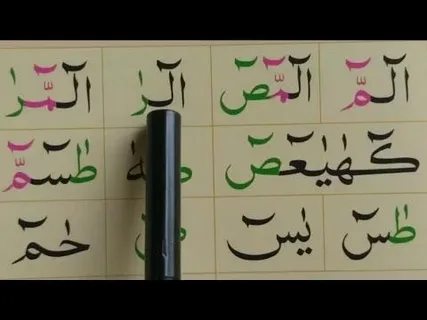Huroof Al Muqatta’at (The Disjointed Letters) are unique letter combinations that appear at the beginning of several chapters (Surahs) in the Quran. In Tajweed, the science of Quranic recitation, these letters hold special significance and require careful pronunciation to preserve the beauty, meaning, and authenticity of the Quranic text. in This article on Arabian Tongue Website we will explores the concept of Huroof Al Muqatta’at in Tajweed, their characteristics, rules for correct recitation, and their role in Quranic studies and spirituality.
What Are Huroof Al Muqatta’at?
Huroof Al Muqatta’at, sometimes called the “mysterious letters,” are sets of Arabic letters that appear individually or in combinations at the beginning of 29 Surahs in the Quran. Examples include:
-
Alif Lam Mim (الم)
-
Ha Mim (حم)
-
Ta Ha (طه)
-
Qaf (ق)
-
Nun (ن)
These letters are pronounced distinctly as individual alphabetic characters, not as words or acronyms. Their exact meaning has been subject to scholarly debate and interpretation for centuries, with some believing they serve as a divine challenge to eloquence and others viewing them as a miraculous element of the Quran.
Importance of Huroof Al Muqatta’at in Tajweed

Tajweed is the set of rules for proper pronunciation and articulation of the Quran during recitation. Since Huroof Al Muqatta’at are unique and highly symbolic, Tajweed for these letters preserves the Quran’s sacredness and linguistic precision.
Key aspects include:
-
Correct articulation (Makharij al-Huruf): Pronouncing the letters correctly by identifying their points of articulation in the mouth, throat, and tongue is fundamental.
-
Madd (prolongation): Some letters require elongation for clarity and reverence.
-
Ghunnah: The nasal sound applicable in certain letter combinations.
-
Sukun and Shaddah: Observing stops and stresses on letters to emphasize their separation or doubling where necessary.
Makharij Al Huroof (Points of Articulation) for Huroof Al Muqatta’at
The first step in Makhraj Huruf in tajweed is knowing the points from which the letters originate:
-
Alif: From the throat’s deepest part.
-
Lam and Mim: Lam from the tip of the tongue touching the upper front teeth and Mim is a labial letter pronounced by closing the lips.
-
Ha and Ta: Ha is a deep breathy sound from the throat, while Ta is tongue-tip touching the upper palate.
-
Qaf and Nun: Qaf is articulated deep in the throat, Nun from the tip of the tongue.
Each letter must be made clearly, neither merging into the next nor making them sound like a different letter entirely.
Rules for Reciting Huroof Al Muqatta’at
-
Distinct Separation: Each letter is pronounced separately with a brief pause (waqf) between them, avoiding liaison.
-
No Combining into Words: Under no circumstances should the letters be combined to form new words; they remain distinct sounds.
-
Emphasis on Articulation: Since these letters are ‘disjointed,’ every letter’s makhraj (point of articulation) must be emphasized extensively.
-
Madd Where Applicable: For example, the Alif is usually elongated slightly when it appears in these letters to allow proper clarity.
-
Observing Shaddah and Sukun: Some letters may have a shaddah (doubling) or a sukun (a state of silence) depending on the specific combination, impacting the intonation.
Examples of Huroof Al Muqatta’at Recitation with Tajweed Rules
-
Alif Lam Mim (الم) — Surah Al-Baqarah:
-
Alif: pronounced clearly from deep in the throat.
-
Lam: tongue presses gently on the upper teeth.
-
Mim: lips close completely, humming softly.
-
-
Ha Mim (حم) — Surah Ghafir:
-
Ha: breathy, deep throat sound.
-
Mim: lips close with nasalization (ghunnah) if shaddah is present.
-
-
Ta Ha (طه) — Surah Ta Ha:
-
Ta: tip of the tongue touches the upper palate.
-
Ha: breathy throat sound, longer duration.
-
-
Qaf (ق) — Surah Qaf:
-
Pronounced from the back of the throat with strength.
-
-
Nun (ن) — Surah Al-Qalam:
-
Pronounced from the tongue tip with nasal ghunnah.
-
Spiritual and Scholarly Significance
The Huroof Al Muqatta’at have fascinated Islamic scholars for centuries. Their mysterious nature invites reflection and humility, underscoring the Quran’s miraculous qualities. Some interpretations include:
-
Divine secrets: Some scholars propose they refer to the names of Allah, His attributes, or ancient lost knowledge reserved by God.
-
A literary challenge: Their presence at the Quran’s start challenges human poets and linguists to match the Quran’s eloquence.
-
Spiritual reminder: Their occasional brief presence during recitation can help reinforce God’s transcendence and the deep meanings embedded in the Quran.
Many scholars advise that aside from correct Tajweed, the reciter should embody humility, reverence, and awareness when pronouncing these letters.
Common Challenges in Reciting Huroof Al Muqatta’at

-
Merging letters: Beginners often accidentally merge letters or pronounce them as single sounds.
-
Incorrect articulation: Misplacing tongue, lip, or throat can alter meanings and detract from reverence.
-
Skipping elongation: Failing to prolong Alif or Ha properly can reduce the clarity and beauty of recitation.
-
Omitting nasal sounds: Missing the ghunnah in certain letters lessens proper Tajweed.
Regular practice under a qualified teacher and using Tajweed audio tools can help overcome these challenges.
Teaching Tips for Students Learning Huroof Al Muqatta’at in Tajweed
-
Begin by mastering the Makharij al-Huruf for all Arabic letters.
-
Practice reciting each letter loudly and distinctly, focusing on correct pronunciation.
-
Use visual aids to learn tongue and lip positions.
-
Repeat recitation slowly, then gradually increase speed while maintaining clarity.
-
Listen frequently to expert Quran reciters and mimic their Tajweed.
-
Seek feedback from a qualified Tajweed teacher.
FAQs
What are the Huroof Al Muqatta’at in the Quran?
They are disjointed letters or letter combinations appearing at the beginning of 29 Surahs, pronounced individually and uniquely.
Why are Huroof Al Muqatta’at important in Tajweed?
They require precise articulation to preserve the Quran’s linguistic integrity and spiritual impact during recitation.
How should each letter in Huroof Al Muqatta’at be pronounced?
Each letter must be pronounced separately with clear articulation from its specific point of origin in the mouth or throat.
Do Huroof Al Muqatta’at form words or have known meanings?
They do not form words; their exact meanings remain unknown or symbolic, viewed as a divine mystery in Islamic tradition.
How can I improve my recitation of Huroof Al Muqatta’at?
Practice with a qualified Tajweed teacher, focus on Makharij al-Huruf, listen to expert reciters, and methodically apply Tajweed rules for clarity and elongation.
Conclusion
Huroof Al Muqatta’at are a unique and spiritually significant aspect of Quranic revelation. Their correct recitation according to Tajweed rules is essential not only for preserving the Quran’s linguistic precision but also for enhancing its spiritual impact on the reciter and listener. Tajweed, particularly for these mysterious letters, requires understanding the points of articulation, proper separation, elongation, and nasalization. While their exact meanings remain among the divine secrets, their presence invites reflection, deepens reverence, and highlights the Quran’s miraculous nature. Through careful study and practice, reciters can honor these divine letters and uphold the true beauty of Quranic recitation.

